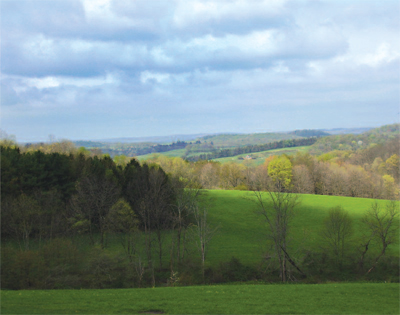Conserving Land
Land conservation has been central to the mission of the Western Pennsylvania Conservancy since the mid-20th century and it remains a critical component of our work today. Since our founding in 1932, WPC has conserved more than 228,000 acres.

Conserved farmland in the Laurel Highlands
In 2009, the Conservancy protected 3,324 acres of natural lands through ten projects. These property acquisitions safeguarded forests, riverfronts and farmland — securing habitat for wildlife and expanding opportunities for people to enjoy the outdoors.
The geographic range of these projects — from Erie County to the Laurel Highlands — speaks to the broad impact of the Conservancy throughout the region.
In 2009, we:
- Acquired 2,400 acres in Clearfield County to protect land and water at the headwaters of Bennett Branch, a tributary to Sinnemahoning Creek. This project built upon the Conservancy’s previous acquisition of 5,300 acres in the Bennett Branch watershed in 2008, as part of our 75th Anniversary Acquisitions.
- Protected 370 acres of forests, historic farmland and rivers and
streams in the Laurel Highlands through four voluntary conservation
easements. These projects, completed in partnership with landowners who
care about our region’s future, protected water quality, preserved scenic
views from the Great Allegheny Passage trail, and conserved forested areas
that shelter wildlife.
- Further protected French Creek, a regional treasure, through the acquisition of a 37-acre property and a 143-acre conservation easement in Venango Township, Erie County.
- Conserved 340 acres of important habitats for wildlife such as the timber rattlesnake, forest interior birds, ruffed grouse, wild turkey and black bears. Also in 2009, the Conservancy launched the innovative Colcom Revolving Fund for Local Land Trusts, which helps smaller local land trusts secure the funds necessary to acquire properties when significant but time-sensitive conservation opportunities emerge.
Our land conservation work also includes stewardship of WPC-owned properties to maximize the conservation values and recreational potential of our lands. In addition, WPC regularly monitors voluntary conservation easements, which are legal agreements with landowners that protect a property’s conservation values while the property remains in private hands. Much of this work would not be possible without the help of many dedicated volunteer land stewards.
Significant stewardship accomplishments in 2009 included invasive plant removal and trail repair at Wolf Creek Narrows Natural Area, Butler County; trail maintenance and tree planting at Bear Run Nature Reserve, Fayette County; trail construction at Lowville Fen Natural Area, Erie County; and debris removal at a conserved property in Erie County.
Maximizing Our Conservation Impact Through Scientific Research
The Western Pennsylvania Conservancy’s science and research programs help to ensure that every dollar we spend to restore a watershed, conserve a forest or protect wildlife habitat is a dollar well spent. Few conservation organizations in the nation benefit from the in-house science expertise that regularly informs our work.
The Pennsylvania Natural Heritage Program (PNHP) at WPC tracks rare and endangered plants and wildlife throughout the state. This program’s data helps to guide WPC’s land- and water-conservation objectives and actions — and beyond that, it also serves as a leading source of information for local governments, municipalities and businesses seeking to make informed decisions about land use.
In 2009, the Natural Heritage Program completed a thorough inventory of important wildlife species in Warren County, bringing the total number of inventories completed by PNHP to 63 across the state. We also worked to update our wildlife species inventory for Erie County. Findings from this study included the first-ever documented dwarf scouring rush plant in Pennsylvania, as well as the discovery of four Blanding’s turtles, which hadn’t been recorded in the state since 1983.
Also in 2009, Conservancy scientists finished the multi-year French Creek biodiversity study, which surveyed fish, mussels and other aquatic life in 10 major tributaries of French Creek and made management recommendations for the creek. In addition, our scientists and conservation planning team analyzed Little Mahoning Creek in Indiana County, as well as Tubmill Creek in Westmoreland County, producing maps and data to guide our conservation actions.
